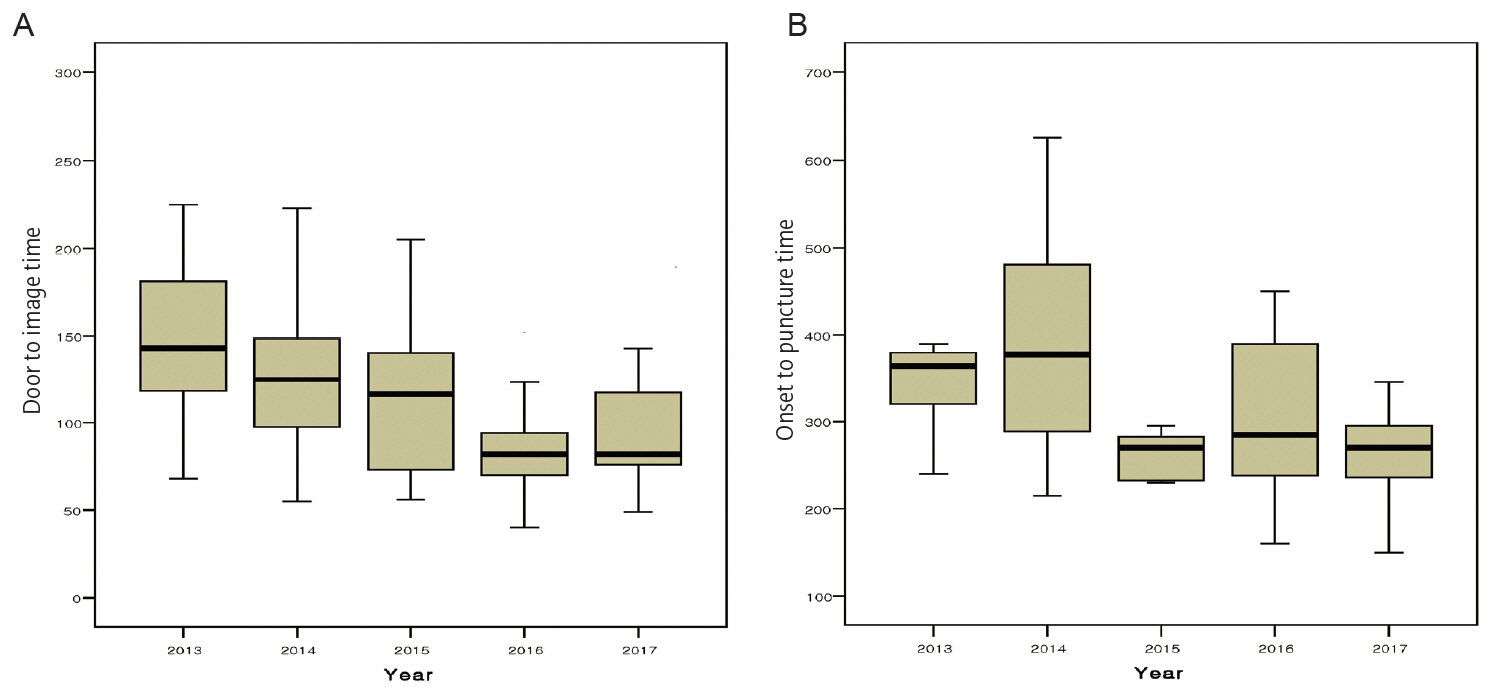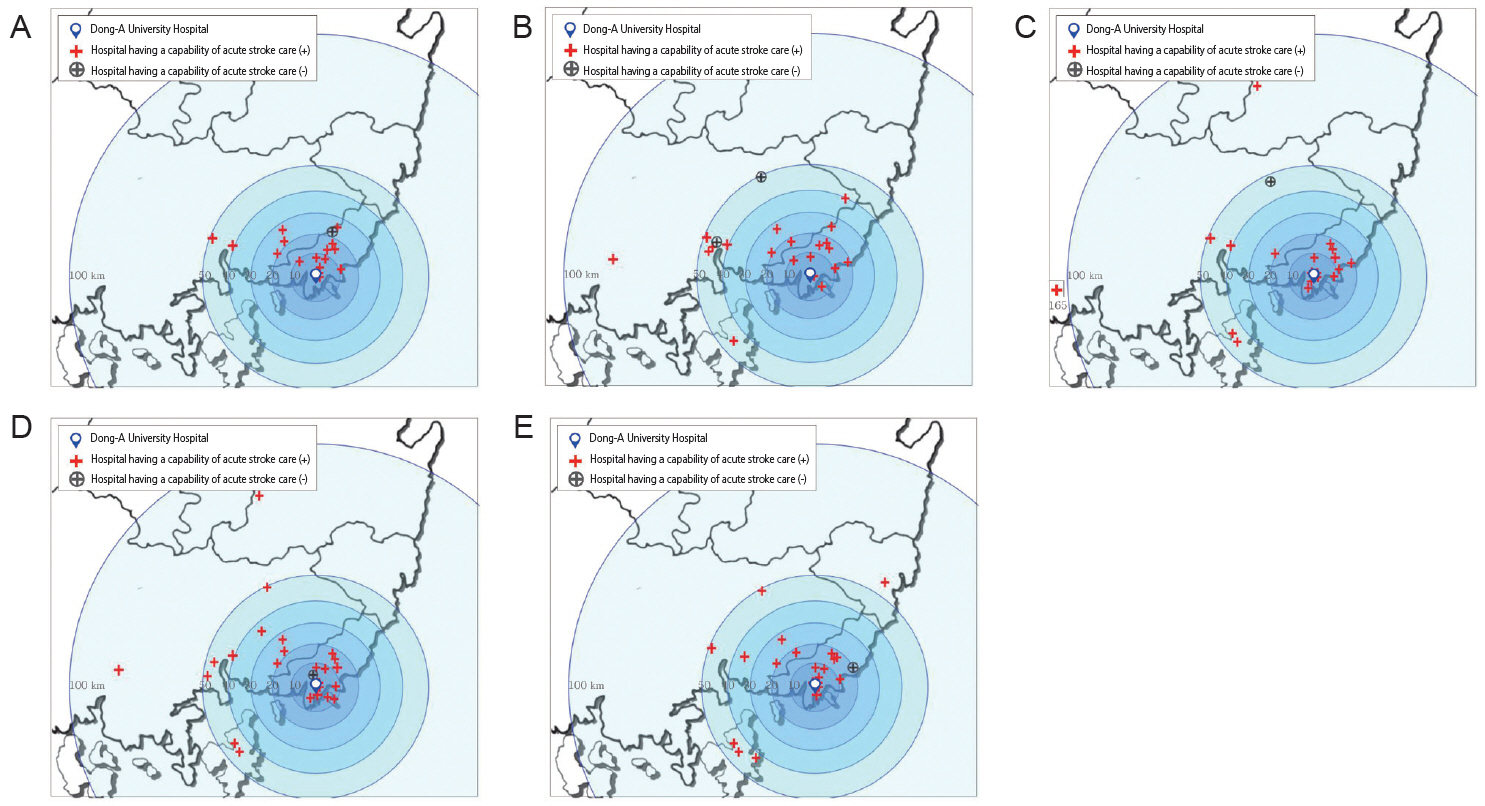J Neurocrit Care.
2018 Dec;11(2):86-92. 10.18700/jnc.180058.
Transportation Time is Significantly Decreased in Acute Ischemic Stroke Patients Under Drip-and-Ship Paradigm for Thrombolysis
- Affiliations
-
- 1Department of Neurology, Stroke Center, Dong-A University Hospital, Dong-A University College of Medicine, Busan, Korea. jhjeong@dau.ac.kr
- 2Department of Intensive Care Medicine, Dong-A University Hospital, Dong-A University College of Medicine, Busan, Korea.
- KMID: 2434834
- DOI: http://doi.org/10.18700/jnc.180058
Abstract
- BACKGROUND
A delay of transfer for patients with acute stroke needing emergent revascularization is a huge hurdle for efficacy of revascularization. The objective of this study was to investigate changes of transportation time calculated by image to door (ITD) time (from checking brain images at first contact hospital to arriving at our emergency center) before and after 2015.
METHODS
This study was performed in a retrospective manner from 2013 into 2017. Acute ischemic stroke (AIS) patients having intravenous thrombolysis and/or mechanical thrombectomy during the observation period were enrolled. Among them, those who had revascularization under "˜Drip-and-Ship' or "˜Ship-and-Drip' paradigm were selected.
RESULTS
During the observation period, 225 patients were treated under "˜Drip-and-Ship' or "˜Ship-and-Drip' paradigm. Twenty-three were excluded due the lack of detailed data. Among 202 patients, 73 and 129 were treated under Drip-and-Ship and Ship-and-Drip paradigms, respectively. In 2013, 35 patients from 18 hospitals (median distance, 25 km) were transferred to our regional stroke center and their median ITD time was 116 minutes. It was gradually decreased after 2015. In 2017, ITD time was significantly (P < 0.01) shortened to 85 minutes without significant changes in transfer distance. The median onset to puncture time was also significantly (P=0.03) decreased from 365 minutes in 2013 to 270 minutes in 2017.
CONCLUSION
Our results implicate that many hospitals in our stroke region might have recognized the importance of rapid transportation for AIS after 2015.
Keyword
Figure
Reference
-
1. Berkhemer OA, Fransen PS, Beumer D, van den Berg LA, Lingsma HF, Yoo AJ, et al. A randomized trial of intraarterial treatment for acute ischemic stroke. N Engl J Med. 2015; 372:11–20.2. Goyal M, Demchuk AM, Menon BK, Eesa M, Rempel JL, Thornton J, et al. Randomized assessment of rapid endovascular treatment of ischemic stroke. N Engl J Med. 2015; 372:1019–30.3. Campbell BC, Mitchell PJ, Kleinig TJ, Dewey HM, Churilov L, Yassi N, et al. Endovascular therapy for ischemic stroke with perfusion-imaging selection. N Engl J Med. 2015; 372:1009–18.
Article4. Saver JL, Goyal M, Bonafe A, Diener HC, Levy EI, Pereira VM, et al. Stent-retriever thrombectomy after intravenous t-PA vs. t-PA alone in stroke. N Engl J Med. 2015; 372:2285–95.
Article5. Jovin TG, Chamorro A, Cobo E, de Miquel MA, Molina CA, Rovira A, et al. Thrombectomy within 8 hours after symptom onset in ischemic stroke. N Engl J Med. 2015; 372:2296–306.
Article6. Adeoye O, Albright KC, Carr BG, Wolff C, Mullen MT, Abruzzo T, et al. Geographic access to acute stroke care in the United States. Stroke. 2014; 45:3019–24.
Article7. Saver JL, Goyal M, van der Lugt A, Menon BK, Majoie CB, Dippel DW, et al. Time to treatment with endovascular thrombectomy and outcomes from ischemic stroke: a meta-analysis. JAMA. 2016; 316:1279–88.
Article8. Badhiwala JH, Nassiri F, Alhazzani W, Selim MH, Farrokhyar F, Spears J, et al. Endovascular thrombectomy for acute ischemic stroke: a meta-analysis. JAMA. 2015; 314:1832–43.9. Menon BK, Sajobi TT, Zhang Y, Rempel JL, Shuaib A, Thornton J, et al. Analysis of workflow and time to treatment on thrombectomy outcome in the Endovascular Treatment for Small Core and Proximal Occlusion Ischemic Stroke (ESCAPE) randomized, controlled trial. Circulation. 2016; 133:2279–86.
Article10. Gerschenfeld G, Muresan IP, Blanc R, Obadia M, Abrivard M, Piotin M, et al. Two paradigms for endovascular thrombectomy after intravenous thrombolysis for acute ischemic stroke. JAMA Neurol. 2017; 74:549–56.
Article11. Daubail B, Ricolfi F, Thouant P, Vogue C, Chavent A, Osseby GV, et al. Impact of mechanical thrombectomy on the organization of the management of acute ischemic stroke. Eur Neurol. 2016; 75:41–7.
Article12. Cha JK, Nah HW, Kang MJ, Kim DH, Park HS, Kim SB, et al. Outcomes after tissue plasminogen activator administration under the drip and ship paradigm may differ according to the regional stroke care system. J Stroke Cerebrovasc Dis. 2014; 23:160–3.
Article13. Sohn SW, Park HS, Cha JK, Nah HW, Kim DH, Kang MJ, et al. A systemized stroke code significantly reduced time intervals for using intravenous tissue plasminogen activator under magnetic resonance imaging screening. J Stroke Cerebrovasc Dis. 2015; 24:465–72.
Article14. Asif KS, Lazzaro MA, Zaidat O. Identifying delays to mechanical thrombectomy for acute stroke: onset to door and door to clot times. J Neurointerv Surg. 2014; 6:505–10.
Article15. Goyal M, Almekhlafi MA, Fan L, Menon BK, Demchuk AM, Yeatts SD, et al. Evaluation of interval times from onset to reperfusion in patients undergoing endovascular therapy in the interventional management of stroke III trial. Circulation. 2014; 130:265–72.
Article16. Sheth KN, Smith EE, Grau-Sepulveda MV, Kleindorfer D, Fonarow GC, Schwamm LH. Drip and ship thrombolytic therapy for acute ischemic stroke: use, temporal trends, and outcomes. Stroke. 2015; 46:732–9.17. Menon BK, Almekhlafi MA, Pereira VM, Gralla J, Bonafe A, Davalos A, et al. Optimal workflow and process-based performance measures for endovascular therapy in acute ischemic stroke: analysis of the Solitaire FR thrombectomy for acute revascularization study. Stroke. 2014; 45:2024–9.18. Goyal M, Jadhav AP, Bonafe A, Diener H, Mendes Pereira V, Levy E, et al. Analysis of workflow and time to treatment and the effects on outcome in endovascular treatment of acute ischemic stroke: results from the SWIFT PRIME randomized controlled trial. Radiology. 2016; 279:888–97.
Article19. Kim HJ, Kim DH, Park HI, Lee IY, Cha JK. Prehospital delay factors after stroke and paramedic identification of stroke patients in a metropolitan city emergency medical service system. J Korean Neurol Assoc. 2011; 29:89–94.20. Park MS, Lee JS, Park TH, Cho YJ, Hong KS, Park JM, et al. Characteristics of the drip-and-ship paradigm for patients with acute ischemic stroke in South Korea. J Stroke Cerebrovasc Dis. 2016; 25:2678–87.
Article21. Kodankandath TV, Shaji J, Kohn N, Arora R, Salamon E, Libman RB, et al. Poor hypertension control and longer transport times are associated with worse outcome in drip-and-ship stroke patients. J Stroke Cerebrovasc Dis. 2016; 25:1887–90.
Article22. Asaithambi G, Chaudhry SA, Hassan AE, Rodriguez GJ, Suri MF, Qureshi AI. Adherence to guidelines by emergency medical services during transport of stroke patients receiving intravenous thrombolytic infusion. J Stroke Cerebrovasc Dis. 2013; 22:e42–5.
Article23. Venema E, Boodt N, Berkhemer OA, Rood PPM, van Zwam WH, van Oostenbrugge RJ, et al. Workflow and factors associated with delay in the delivery of intra-arterial treatment for acute ischemic stroke in the MR CLEAN trial. J Neurointerv Surg. 2018; 10:424–8.
Article24. Bae HJ, Kim DH, Yoo NT, Choi JH, Huh JT, Cha JK, et al. Prehospital notification from the emergency medical service reduces the transfer and intra-hospital processing times for acute stroke patients. J Clin Neurol. 2010; 6:138–42.
Article25. Kim DH, Nah HW, Park HS, Choi JH, Kang MJ, Huh JT, et al. Impact of prehospital intervention on delay time to thrombolytic therapy in a stroke center with a systemized stroke code program. J Stroke Cerebrovasc Dis. 2016; 25:1665–70.
Article26. Sun CH, Nogueira RG, Glenn BA, Connelly K, Zimmermann S, Anda K, et al. "Picture to puncture": a novel time metric to enhance outcomes in patients transferred for endovascular reperfusion in acute ischemic stroke. Circulation. 2013; 127:1139–48.
- Full Text Links
- Actions
-
Cited
- CITED
-
- Close
- Share
- Similar articles
-
- Intra-Arterial Thrombolysis after Full-Dose Intravenous tPA via the "Drip and Ship" Approach in Patients with Acute Ischemic Stroke: Preliminary Report
- Mothership versus Drip-and-Ship Model for Mechanical Thrombectomy in Acute Stroke: A Systematic Review and Meta-Analysis for Clinical and Radiological Outcomes
- Treatment of Acute Ischemic Stroke: Thrombolysis
- Interventional Recanalization Treatment of Acute Ischemic Stroke
- Intravenous Thrombolysis and Endovascular Thrombectomy in Acute Ischemic Stroke with Minor Symptom



